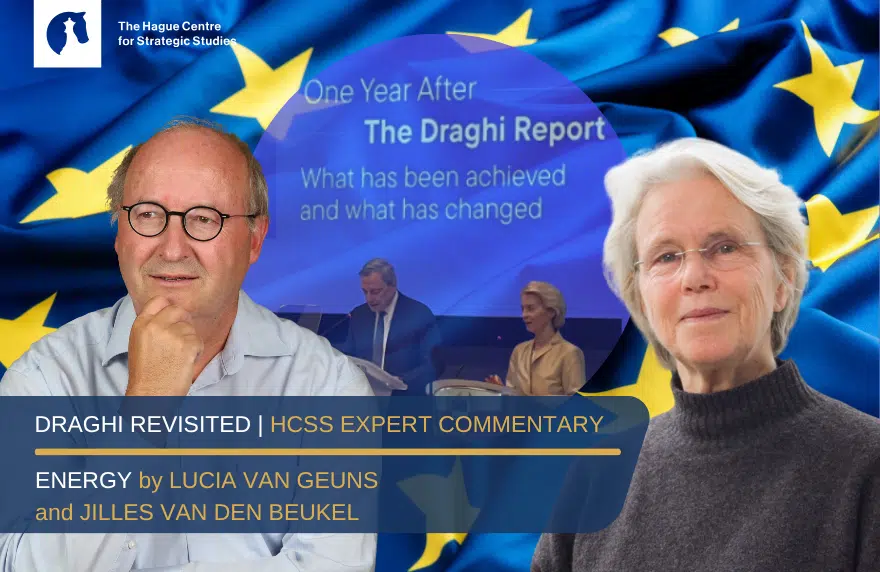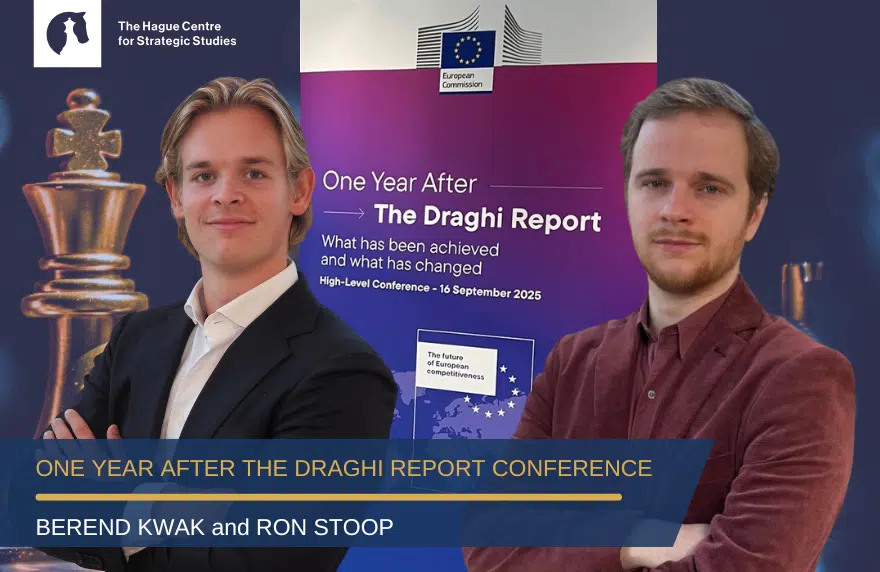One year after Mario Draghi’s landmark report on Europe’s economic future, HCSS launches the second edition of its Draghi Report Series.
Despite political attention, Europe still struggles with dependencies in defence, raw materials, cleantech, and digital domains. Global tensions with both China and the US are mounting, and Europe’s trade model faces unprecedented pressure. Progress has been uneven and often too slow due to coordination, financing and other internal barriers.
Last year, Ron Stoop and Berend Kwak examined the long-term implications of Draghi’s recommendations in a series of interviews with our experts. Now, they return to assess how far Europe has come in addressing his urgent call to secure industrial, technological and economic sovereignty.
In this new series, HCSS analysts revisit Draghi’s warnings sector by sector.
For the fifth article, strategic advisors Lucia van Geuns and Jilles van den Beukel assess how far Europe has come in strengthening its energy competitiveness and sovereignty — and how far it still has to go.
Since the publication of the Draghi Report, what concrete steps have been taken at the EU and member state level in this sector, and how effective have they been so far?
Lucia van Geuns: A year after Mario Draghi’s competitiveness report, Europe faces even greater urgency to act on his recommendations to avoid economic decline. The top priority is completing the single market, which would remove significant internal trade barriers. This requires not just regulatory convergence but strategic actions in key sectors.
Energy policy is a prime example. While broadly aligned with Draghi’s agenda, concrete steps are scarce. Joint gas purchasing and market integration remain limited; electricity–gas price decoupling has barely advanced. Tools such as PPAs (Power Purchase Agreements) and CfDs (Contracts for Difference) essential for long-term investment certainty, are still missing. Initiatives like joint procurement platforms have failed to leverage Europe’s market power — even as the EU commits to buying $750 billion of US energy by 2028.
True electricity market integration will require substantial hardware and software upgrades, alongside centralised cross-border decision-making. Planned 2026 reforms must mark a decisive step toward a genuine EU electricity union — one that strengthens competitiveness, security and decarbonisation simultaneously.
Jilles van den Beukel: Key energy themes in the Draghi report were Europe’s high energy costs, a large dependency on imported fossil fuels and a need to accelerate the energy transition. All in order to improve Europe’s competitiveness.
Reducing the dependency on imported fossil fuels is a long-term project that has seen limited progress. Good developments have been the implemented sanctions on the import of Russian oil and oil products and the forthcoming sanctions on the import of Russian LNG.
Europe’s energy costs (electricity, natural gas) have been decreasing but this is not so much the result of EU measures like a joint procurement of natural gas (a measure that is simply not effective and has been implemented for limited volumes only) but rather the large amount of LNG that is coming on the market in the 2025-2028 period.
The acceleration of the energy transition is stalling. Offshore wind and solar electricity generation has increased over the previous years but both sectors are now facing substantial financial difficulties. The reform of electricity markets, needed to ensure that decreasing costs of solar and wind reach end consumers to a greater extent, has not been implemented but some measures have been taken. Again, this is a long-term process.
Where do the biggest gaps lie between political ambition and practical implementation, and why do they exist?
Lucia van Geuns: Across the board, Europe faces the same problem Draghi diagnosed: grand visions, but little coordinated action. In July 2025, the EU Commission gave countries more leeway to subsidise industrial energy use, tied to decarbonisation. But this carries risks: shifting costs to households, sparking subsidy races, and propping up energy-intensive production that should relocate to cheaper clean energy hubs. Fragmentation persists in energy, industry and state aid. State aid rules block collective action; member states undercut each other, with Germany’s car subsidies angering France, and the Netherlands lacking an industrial vision altogether. Member states often block one another’s initiatives; strategic coherence is lacking. While the US and China deploy massive state support with clear priorities, the EU hesitates.
Jilles van den Beukel: Europe wants to be a front runner in the energy transition but its capacity to do so is limited in a world that is, de facto, lining up for a slower energy transition. Now, Europe’s energy-intensive and petrochemical industries are struggling to survive; they need to be supported.
Looking ahead, what should be the EU’s top two or three priorities to stay competitive, and where might it make sense to scale back?
Lucia van Geuns: Europe needs to build a unified, innovation-driven economic framework to boost competitiveness and growth. No more declarations but a new European economic model: more integration where it counts, smarter investment, and vertical economic coordination. Europe must focus its efforts, deploy real financial firepower, and build the strategic backbone Draghi called for.
In the Netherlands a new industrial policy with six growth markets have been presented: semiconductors, biotechnology, defence, AI, mechanical engineering and innovative chemistry. A concrete action perspective, however, is still lacking.
Jilles van den Beukel: A consistent strategy and consistent policies. Investments to alleviate issues like net congestion, without transferring the associated costs to industrial end consumers. A political and societal push to support industries, generating income for Europe in the long term, rather than to increase the income of European citizens, generating votes in the short term.
Scaling back industry segments at a national level may be acceptable, but care should be taken that strategic industry segments do not leave the EU altogether.
If we meet again in a year, what single measurable outcome would convince you that Europe is on the right track in this sector?
Lucia van Geuns: EU struggles with fragmentation, slow implementation, and a lack of collective strategic direction. Europe is on the right track if it has removed internal barriers by pooling resources strategically and has modernized regulation.
Jilles van den Beukel: The single outcome that would convince me most is that industrial demand for green energy and products increases. It may be necessary to promote renewable electricity with short term measures like PPA’s (Power Purchase Agreements) but I would prefer that renewable energy is helped by industrial demand (and vice versa industrial demand is helped by low-cost green electricity).










